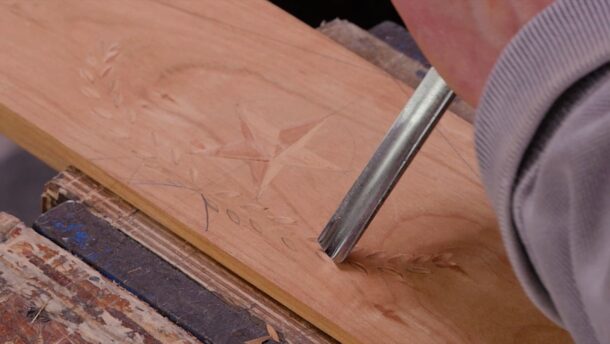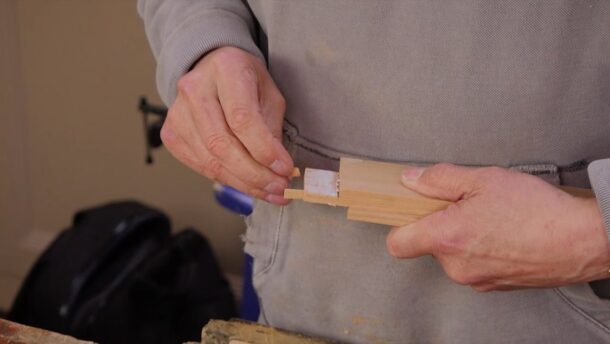Carved Mirror Frame: Project Info
Posted 3 May 2016
This is the introductory page for a paid video series. Want to watch more of this project? Select the best option below to get started.
Description
Paul shows what he does to complete a commission for a mirror. There are a few interesting features to look out for including staggered shoulders on the tenons, fox-wedging and handmade turnbuttons as well as an introduction to decorative carving, including chip carving.
The tools you will need are:
- Knife
- Square
- Combination gauge (or marking gauge and mortise gauge)
- Tape/Ruler (or both)
- Sliding bevel
- Chisel hammer
- Chisels (at least 1/4″ and 1″)
- Fingernail Gouge (narrow & shallow)
- Smoothing plane (No 4)
- Plough Plane
- *Scrub Plane
- Mortice guide
- Handsaw
- Tenon saw
- No 80 Cabinet Scraper
- Card scraper
- Brace & bit/hand drill/drill driver
- Square Awl
- Small steel hammer
* = optional







I started on canes and walking sticks; it seems just about everyone wants one. I do.
What a fantastic first project in your new location! We don’t now really need tables, chairs, tool chests, and many other things of which we are in fact divesting. But at our age, canes and walking sticks are great to have, and there’s always room for an extra mirror or two to help remind us that we are definitely at our age. Maybe make a cane stand to put near the reminder mirror!
Looking forward to it! Thank you so very much for this gift you’ve given.
A bit of carving. This should be fun.
Another great small project. I look forward to seeing it.
I do like a bit of chip carving, it’s worth it, handy skill to fix mistakes and to sign the projects, looking forward to it.
Paul’s projects, such as this one (which I am starting off on) calls for ¾” stock. I’m choosing cherry, and here in the states, our hardwoods are sized as 4/4 or 5/4, etc. But 4/4 stock is actually 13/16″. Is this the same in the UK, and if so, how does Paul size it down to ¾”? Of course if I don’t reduce the stock, I can just adjust the measurements accordingly, but with this project in particular, the details get complicated quickly.
Our buy-it-in ready-milled wood actually finishes out at 13/16″ too. Sometimes I mill my own. and sometimes I buy in. When I mill my own it comes to me at around 1 1/8th so I have plenty of wood to mill it down to say 7/8″ and even 1″. My choice in the moment. When I refer to 3/4″ stock it means I usually bought in wood because that is what the majority of followers will do. Planing off the surfaces takes the size down to an unpredictable outcomes so using a standard size means we can accomodate discrepancies expected by those using hand tools. It’s a ballpark size in other words but it works fine. Most people will indeed adjust their sizes accordingly as you say.
A chum of mine has just given me an old mirror from his flat. It is 50cm by 100cm with beveled edges. I would like to cut it in to 3 pieces, and then make 3 mirror frames.
Now, as I have never cut either glass or mirror, I do have a couple of questions.
I have seen in the past (watching my cousin a looong time ago) that to cut glass you need a diamond wheel cutter (will buy that at the weekend), a straight edge to run it against (check), and a small lip to put under the cut line to help the break (will be able to set that up).
Questions.
Am I right in thinking that I also have to score down the bevels?
Are there any differences between cutting glass in this manner and cutting mirror? (Thinking specifically if I need to do anything on the back to avoid damaging the coating etc.)
Colin.
Hi Colin,
Paul says:
In my experience, cutting old mirror and glass never goes to plan. You will not be able to rely on perfect cuts resulting from it. It is more likely to run corner to corner than straight to line, as Craig has suggested, going into a glass shop they might do it for you but it’s doubtful.
Kind Regards,
Izzy
Colin,
I would suggest taking the mirror to a professional glass shop and have them cut it to the sizes you need.
If it’s a bad idea, they’ll let you know right away.
Shouldn’t cost much, and you’ll benefit from their expertise
Best,
Craig